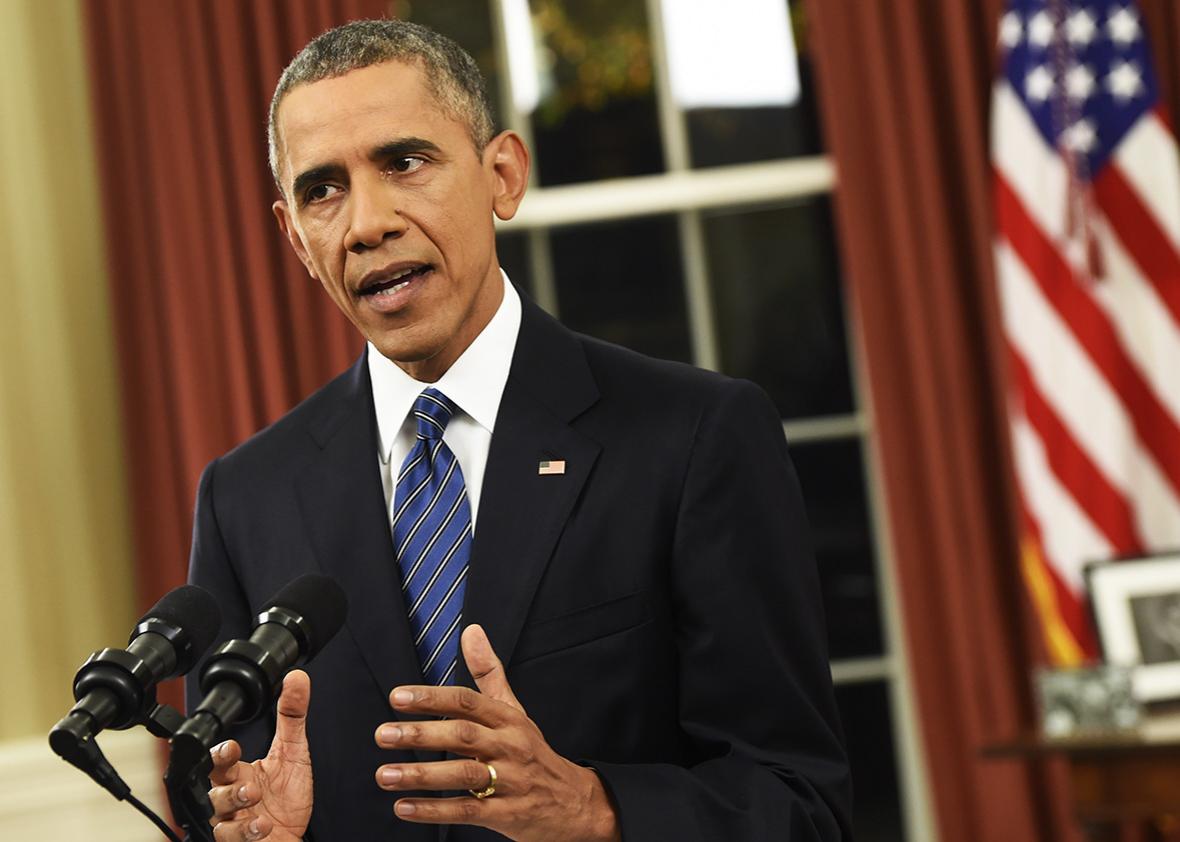Democrats running for president have expansive plans for gun control, but they sit at the far edge of the possible. Barring a Democratic Congress in 2017, neither Hillary Clinton nor Martin O’Malley nor Bernie Sanders will be able to turn their ideas into law. Until then, liberals and gun control advocates will have to live with small change on the margins. On Sunday, in a rare address from the Oval Office, President Obama offered two such measures: a new assault weapons ban and a law to block gun ownership for anyone on an official no-fly list.
“Congress should act to make sure no one on a no-fly list is able to buy a gun. What could possibly be the argument for allowing a terrorist suspect to buy a semi-automatic weapon? This is a matter of national security,” said Obama. “We also need to make it harder for people to buy powerful assault weapons like the ones that were used in San Bernardino.”
Both policies are en vogue with national Democrats and some liberals. Senate Democrats—led by California Sen. Dianne Feinstein—have already pushed (and failed to pass) a bill to prevent anyone on the FBI’s terror watchlist from buying a firearm in the United States, while—in an almost unprecedented front-page editorial—the New York Times called for politicians to outlaw “certain kinds of weapons” like “slightly modified combat rifles and certain kinds of ammunition” for civilian use.
Although well-meaning—supporters genuinely want to keep military-style weapons “off the streets” and guns out of the hands of suspected threats—both measures are wrongheaded.
There’s no doubt assault weapons—there’s no official definition for the term, which makes identifying them for prohibition difficult, if not impossible—are scary to many Americans, especially with their presence in high-profile shootings like the massacre at Sandy Hook Elementary in Newtown, Connecticut, or the theater killings in Aurora, Colorado. But out of 73 mass killers from 1982 to 2015, just 25 used rifles of any kind, including military-style weapons. Most used revolvers, shotguns, and semi-automatic handguns. Which gets to a related point: We might feel safer if we ban “assault weapons,” but we won’t be safer. Of the 43,000 Americans killed with guns since 2010, just a fraction—3.5 percent—were killed with rifles.
The vast majority of gun murder victims are killed with handguns. But a handgun ban isn’t on the table, and for good reason—with its opinion in District of Columbia v. Heller, the Supreme Court stated an individual right to gun ownership. And under Heller, handguns are weapons in “common use” for “traditionally lawful purposes” like defending a home. A ban would be unconstitutional.
The no-fly list isn’t officially unconstitutional (neither is the FBI terrorist watch list), but civil libertarians—and liberals, at least during the Bush administration—think it’s constitutionally dubious. They’re right. “The list contains the names of people who the government thinks are a threat to civil aviation—terrorists,” writes University of Chicago law professor Eric Posner for Slate. “These people are denied passage. … Yet the government does not have proof that these people have committed crimes nor, since it can’t see into the future, that they will commit crimes.” If you’re on these lists, you’re presumed guilty until proven innocent, with no due process and little recourse.
The list is conceptually flawed, and using it to deny gun ownership is wrong on its face. Add racial and religious profiling to the mix—the people on the list, including Americans, are disproportionately Arab or from Muslim countires—and you have an anti-gun measure with deep disparate impact.
Support for near-unlimited gun rights is as close to a litmus test as you get in conservative politics, which makes federal gun control a nonstarter in our era of divided government. But if you support gun control and want something good—and not just “something”—then this is a blessing.
The sooner Democrats abandon ineffectual gun control measures, the sooner they can turn their attention to ideas that would actually limit gun accidents, suicides, and murders. Some of those are in plans presented by Clinton and O’Malley: tougher and more comprehensive background checks; legal liability for gun sellers and manufacturers; tougher penalties for “bad actor” dealers that “knowingly supply straw purchasers and traffickers”; ownership bans for people “involuntarily committed to outpatient treatment,” convicted of domestic violence, or subject to emergency restraining orders; required safety standards for gun storage; and mandatory reporting of lost or stolen firearms, facilitated by technological advances. Even if these are hopeless at the federal level, a national Democratic push might inspire lawmakers at the state and local levels to take action and begin to build momentum for when national change is possible.
In all of this, however, gun control supporters should keep one fact in mind: The United States is saturated with guns, and barring confiscation or mandatory buybacks, there’s no way to end mass shootings. And as a large, pluralistic society with a long and varied tradition of gun ownership, there’s little chance of a broad, anti-gun consensus. Sensible, effective regulation is the best bet for action.
You can read that as futility, but it’s not. It’s a recognition of reality and a plea for perspective. We don’t have to end mass shootings to make serious progress on gun violence. An America where fewer young men are killed in inner-city shootouts—where fewer women are dead at the hands of abusers and where fewer children lose their lives to accidents—is a victory. We shouldn’t let the focus on mass shootings obscure that.
Read more of Slate’s coverage of the San Bernardino shooting.
